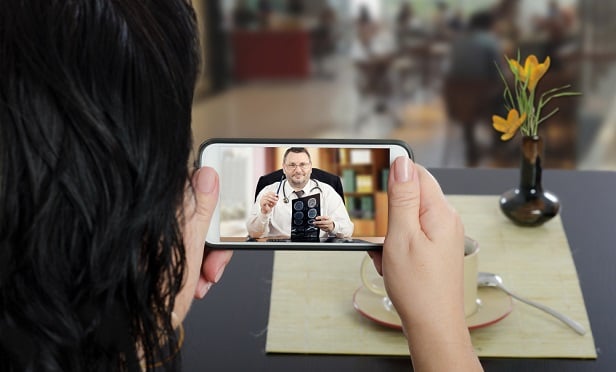 Previously overlooked by some employees, local physicians using telehealth and national providers are seeing a significant surge in appointments. (Photo: Shutterstock)
Previously overlooked by some employees, local physicians using telehealth and national providers are seeing a significant surge in appointments. (Photo: Shutterstock)
The ongoing COVID-19 emergency continues to change the way Americans live and work, while altering how people navigate the health system. Given more than half of Americans have health care benefits through their place of work, employers are uniquely positioned to help employees maintain or improve their well-being during these difficult times.
Enter telehealth, an increasingly popular option for medical advice amid the COVID-19 situation. Previously overlooked by some employees, local physicians using telehealth and national providers are seeing a significant surge in appointments as more people use digital devices to access care and medical advice virtually, including with behavioral health specialists and physical, occupational and speech therapists. The motivation: Improving access to more affordable, convenient care, while reducing potential exposure risks to COVID-19 associated with in-person trips to health care facilities.
Related: Virtual care 2020: What's next?
With more than half of employers reporting that virtual solutions rank as a top health priority, here are strategies organizations may consider to help maximize the value of those efforts:
1. Start or expand access
Most large employers offer at least some type of telehealth benefit to their employees, so improving employee awareness and use of this technology should be a priority. Corporate executives and human resources leaders at companies of all sizes should continue to evaluate what telehealth options may be currently available to employees through their health plan, local care providers or other telehealth service providers.
To help make these resources more convenient, some options give employees 24/7 access to virtual visits that – while unable to diagnose or treat COVID-19 – can provide medical advice related to this condition (including guidance for in-person testing and treatment, if needed) and other health issues such as allergies, rashes or flu. Currently, some health plans are waiving member cost-sharing for telehealth visits, including those related to COVID-19.
2. Consistently communicate
Employers may consider creating consistent–and customized–communication strategies to help encourage the adoption of telehealth resources, especially in connection to COVID-19. In fact, 63% of people report they would like information from their employer about COVID-19 at least daily. To help encourage people to start and continue using telehealth resources, some employers send out welcome kits, monthly email reminders and direct-mail materials that highlight the potential convenience, flexibility (24/7 or scheduled appointments) and affordability of this technology. Tailored communication strategies – informed by deidentified claims data – may help more employees access relevant resources.
3. Offer Incentives
In general, people may be motivated by a combination of intrinsic factors, such as wanting to help maintain or improve personal health and avoid disease, and extrinsic ones, such as financial rewards. To help encourage the latter, employers may consider offering employees financial incentives for using telehealth resources.* For instance, across a group of small, mid-sized and large employers, employees had the opportunity to receive a $5 pre-paid gift card for completing a virtual visit registration, helping generate a 40% increase in sign-ups compared to a control group.
4. Add virtual wellness programs
Besides telehealth, employers may consider adding or expanding virtual wellness programs, including ones that are designed to help employees prevent or better manage certain chronic conditions (such as diabetes or obesity) that may be risk factors for complications related to COVID-19. For instance, employers may be able to provide virtual programs that give employees personalized, interactive online weight loss support, which may help motivate people to get active. With many gyms and other exercise facilities currently closed, at-home support programs may be increasingly valuable.
Employers may also consider telephonic programs that connect people with licensed counselors to help address various issues, including family and marriage difficulties, alcohol or substance misuse, and depression or stress.
Driving more consistent use of virtual resources may encourage healthier and more productive employees, while curbing health care costs by helping people avoid potentially riskier in-person health care settings amid the COVID-19 emergency and in the future.
Dr. Donna O' Shea is chief medical officer of population health management for UnitedHealthcare.
Read more:
© Touchpoint Markets, All Rights Reserved. Request academic re-use from www.copyright.com. All other uses, submit a request to [email protected]. For more inforrmation visit Asset & Logo Licensing.






